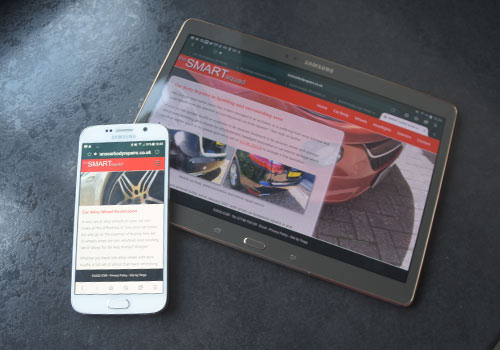What is obvious
When having a website built, preparing a new marketing campaign or making some changes to your buying process, you (as an individual or as an organisation) might be biased towards what you believe are the obvious
things that your customers need to do when they land on your website, and at each step of the process.
So if people don't click on what you consider to be obvious, do that makes they're stupid?
Not so...
Remember that you're probably an expert in your field, and your typical customer is unlikely to have the same insight and level of knowledge and experience that you do.
How easy is your customer journey?

The term customer journey
is used to describe the process or steps that a potential customer takes through the buying process.
It can start at the homepage of your website, a landing page for a special offer, an email promotion, a direct link from a portal on a corporate partner's website or intranet, or one of many other starting points. And ideally it should end with a purchase, an order confirmation email, or some other indication to show that you have just made a successful sale to a customer who will hopefully return to do it all again.
It's obvious what the customer needs to do, right?
So what could be in a customer journey which is worth you paying attention to? After all, it's obvious what the customer needs to do, right?
What is the perfect customer journey?
When the buying path starts at A and ends at Z with no deviations in between, you might be able to design the perfect customer journey which is intuitive enough to allow your potential customers to easily find what they want, add it to their shopping basket.
Then they'll select from the delivery options, enter their details, pay, buy and receive confirmation via screen and email.
Easy, right?
Even such a straightforward vanilla
A-Z path like that would need to be tested from the customer's perspective to ensure that it is easy to use, and that things and features are where the customer expects them to be, and that they do what the customer expects them to do.
But...
- What if the customer wants to locate additional information about the product, such as features, technical information, dimensions, manuals, etc?
- What about evaluating alternatives?
- What about special offers, multi-buy deals, and benefits for loyalty scheme members?
- Are your delivery options and returns policies clear?
- What about warranty?
Are these options and information available, and easy to access and use?
Unless you ask others to evaluate that experience for themselves with no prior knowledge of your website or your products, how can you gauge what your customers will think?
Your customers are unlikely to be familiar with jargon which you use every day, and might be completely unaware of what the fancy icons you have added to your web pages mean. So how do you know how easy or difficult it would be for a potential customer to use your website?
Let's look at a real life example
My daughter recently purchased gift vouchers for a visit and drinks at The Shard in London. For me to redeem the voucher she read out instructions to go to their website and click on Got a Voucher
Here's what happened:
- I went to the website, and it loaded with a colourful background image and lots of things to click on. But the instructions on my gift voucher told me to find
Got a Voucher
- Within seconds the mandatory cookie acceptance overlay appeared in the centre of the screen, so I accepted the cookie options to close it.
- With my eyes still being drawn to the centre of the page, I continued looking for
Got a Voucher
amongst several rows of navigation options and calls to action (CTAs). - Within a couple of seconds a £10 Discount Code offer popped up in a modal the middle of the screen, encouraging me to sign up. All I wanted was to redeem an existing voucher, so I closed that discount modal and continued looking for
Got a Voucher
- I scrolled down the page very slightly, but I still couldn’t see it, so I used [CTRL-F] on my Windows laptop to search the page.
- Great... found it at last... right at the bottom of the page in the footer!
- I wondered why it was positioned at the bottom of a very long page, but there it was. So I clicked the button and redeemed the voucher.
Second time lucky?
On my 2nd visit to the site to redeem a meal voucher, I realised that Got a Voucher
was actually at the top very of the page on the right. So how on earth did I miss it before?
This is why:
Got a Voucher
is a button which is the same colour as the navigation bar which it sits in.- Although the button has a thin white border, it wasn't prominent enough for me to locate before the cookie acceptance modal drew my attention to the centre of the screen.
- I was then further distracted by the £10 Discount modal popping up in the centre of the screen.
- More significant was that I realised that by scrolling the page even very slightly, the top navigation bar collapsed and hid the
Got a Voucher
button, and it only re-displayed if the user scrolls up to the very top of the page. - That’s why I missed it!
The above experience was made more difficult than it should have been by a combination of things, but thankfully since this article was first written, the problem with the button being hidden when scrolling has been resolved.
But consider this...
I didn't go there to make a purchase. I went there to redeem a voucher that my daughter had already given the company money for, so a poor experience wasn't going to make me decide to go to another website like I might have otherwise done.
No... I HAD to use THAT website!
Don't make your customers do your testing
Experience suggests to me this wasn't tested from the perspective of a customer wanting to redeem a voucher, in conjunction with the colours, positioning, distractions and collapsing navigation bar.
It's certainly not a good idea to let your customers test for you, because you will want to find and fix anything which could result in failure or frustration before your customers do.
So what would I recommend?
User Testing!
What is User Testing?
To have someone independent who can take on a customer persona for a certain customer type and report back to you on their experience is basically what user testing is about.
Does this mean that literally anyone could do your user testing for you?
Well in theory, yes. But if their experiences could be recorded in a way that allows you to physically see how they interacted with your website, and hear them thinking out loud as they looked for products, features, options, information, etc., this can be very valuable feedback.
They could describe what they liked or disliked about their experience, and whether they found anything to be confusing, distracting, cluttered, hard to read, etc. There might have been requirements or expectations which were either met or missed, and they might have some useful suggestions for improvement.
On the other hand, if your website was aimed at B2B, then it may be necessary to have someone with prior knowledge of your company or sector to test.
Any feedback could be communicated back to your marketing team or your web development team so that any suggestions for changes or improvements can be considered.
How is User Testing Done?
For some smaller companies it may only be possible to conduct user testing on their live website, although in some cases separate pages may be set up specifically for testing. For other companies it may be possible to have the testing done in a pre-production
staging environment, which is not made accessible to the general public.
There are several methods which can be used, and these can depend on your objectives, what needs to be tested, and your budget.
Low Tech
The low tech options would include someone simply going to your website, carrying out some tasks and telling you about their experience. This could be verbal, or it could be documented or emailed. And if emailed, screenshots could be attached.
Those methods would represent the cheapest user testing options, but could still provide very useful feedback.
Group Observations
User testing can take place in a purpose built environment, which could include a seated area with laptops or mobile devices where participants (often paid volunteers) will be given specific tasks to carry out. Their actions and reactions will be observed and recorded, including any comments they have about their experience.
Screen Recordings
Taking a more modern approach, a higher tech option could involve screen recorders. This allows paid volunteers to participate in user testing from home, where their actions on a website or prototypes of page designs are captured by a screen recorder, along with a verbal narrative from the person testing, as they speak into a microphone.
To see how people interact and hear their thoughts put into words in real time can be really useful, as it will give you an insight of what people are finding easy, difficult, frustrating, and sometimes not finding at all! User Testing on mobile devices in this way is also possible.
Targa uses screen recording for user testing, which results in videos with live commentary. Depending on the purpose of each test and what issues have been discovered, these videos can range from a few minutes to an hour or more.
Heat Maps
Heat maps can also be a really useful and interesting way of analysing user behaviour by seeing where users spend their time on a web page. If a user spends a lot of time in a specific area of the page, it will show as red (hot), and a colour spectrum through to blue for the coldest areas is used, where blue would show where the least time was spent.
Test with a purpose
Whichever method is used, testers really need an objective... a purpose. You won’t get valuable feedback by just asking someone to visit your website and let you know what they think. You need to give them a task, and even adopt a customer persona.
You might not like what they tell you!
Not all feedback will be what you want to hear. You might be not be happy to hear that the costly new homepage layout performs worse than its predecessor (nor will your boss!), but it is the user’s opinion which counts.
If you ignore what they tell you because you're too emotionally tied to your new design, it could cost you in lost business! This is the whole point about testing!
In summary, it's fair to say that user testing is not rocket science, but it should be taken seriously. Don't assume that your potential customers are experts, but don't be patronising with your designs either.
Don't make them have to think too hard, and very importantly, listen to what your testers tell you. And if you take suggestions on board and make changes, get it tested again!
Whilst Targa covers a wide range of testing methods, the US based company UserTesting comes highly recommended for user testing with multiple participants. They operate globally, and provide a wealth of resources, tutorials, and information to get you set up.

This article was written by Daron Harvey, founder of TargaWeb. Daron is now in his 29th year of professional website design, development, testing and management, including 21 years on the development and management of Hertz multilingual global e-commerce platform.






